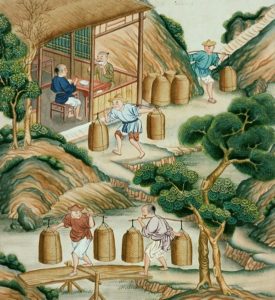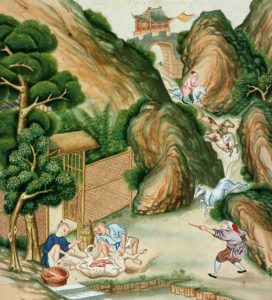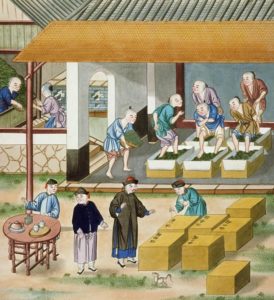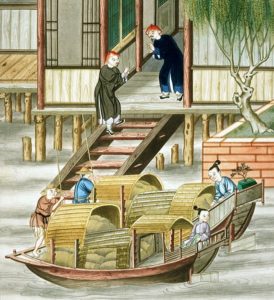Depictions of Chinese Tea Culture for the Western Market
EMERGING SCHOLARS > CONTINUING EDUCATION SCHOLARSHIPS
Tammy Hong,
Andrew W. Mellon Research Assistant in Modern Materials, National Gallery of Art
As a part of Historic Deerfield’s restoration, Henry and Helen Geier Flynt—the founders of the historic village museum—intended to establish a collection of antiques that underline a distinctly American cultural aesthetic. In order to further explore the nuances of the Flynts’ collecting intention, I selected a late-18th-century Chinese watercolor album depicting phases of the production of tea for my research project in Historic Deerfield’s Summer Fellowship Program. The accordion-style album was produced for the export market about 1790 and contains 24 paintings. My research highlights elements of Chinese culture found in the renderings that are often missing from Western scholarship on early Chinese export watercolors.
The newly formed United States first established direct trade with China in 1784. Previously, American perceptions of Chinese export goods were filtered through the lens of the British and European merchants who facilitated their availability. The narrative of Deerfield’s tea album offers insight on the evolving exchange between China and the West in the late 18th century. Although the watercolors’ visual aspects might suggest Western influences, they also testify to the Chinese artistic traditions and culture that emanate from the images.
Tea production was a subject of fascination for many Westerners, and Deerfield’s album offered its owners nuanced information about the industry when foreign access to China was restricted during the Qing dynasty to the port of Canton (广州 Guǎngzhōu), a policy known as the Canton, System (一口通商yī kǒu tōng shāng, 1757-1842). Depictions of Canton and of the tea, silk, and porcelain trade transacted at the Chinese port, were brought home by Western merchants as testimonials of the exotic and secretive processes that generated these desirable luxury goods.
Helen Geier Flynt acquired the watercolors from the renowned American antiques dealer J.A. Lloyd Hyde, but no additional provenance survives. Only one other comparable assemblage is known in a museum collection, an album owned by the Musée des Beaux Arts in Rennes, Frances, which is a decade or two older and retains an intact history. Pierre-Louis Achille de Robien purchased the Rennes set in Canton between 1767 and 1777 as a gift for his relative Paul-Christophe de Robien along with a second set depicting porcelain production. The Deerfield album’s more vibrant colors and refined perspective reinforce a later date.
The visual qualities of such richly illustrated watercolors was fanciful and unconventional relative to Western tastes yet approachable and informative. Art historians suggest that Chinese artists were not exaggerating traditional techniques to enhance the exotic nature of such work, rather rendering these images in a traditional and analytical manner. The simple flatness of their style relies on a subtle one-point perspective that incorporates delicate brushwork to generate sweeping panoramas. Grounded in Chinese painting traditions, the watercolors faithfully portray the Chinese tea industry.
An analysis of a classic Chinese treatise on tea production documents the accuracy of the Deerfield album. Lù Yü (陸羽) wrote the Classic of Tea (茶经 chá jīng) in 760 A.D. during the Tang dynasty, codifying each step of cultivation and processing that enabled the distribution of this coveted material. Each phase of tea agriculture is represented in the Deerfield watercolors, which were bound out of sequence and are supplemented by two mythological scenes tied to the tea industry. The watercolors are individually labeled in English, likely by the purchaser or the recipient, to whom the scenes were described by someone familiar with the tea industry. The production of both green and black teas is illustrated in the series.
The sequence begins with a depiction of “The Bohea Country,” where China’s most sought-after teas were grown, and continues with the cultivation, processing, packaging, and delivery to Canton. The impressive detail of each rendering provides a clear understanding of the activity, serving as de facto illustrations of Lù Yü’s 8th-century volume, Classic of Tea. The majority of the watercolors are dedicated to the rendering of tea through the various stages of transport from the interior to the coast, including the production of the baskets, canisters, and chests required to move the precious commodity. The final view, “Taking leave,” depicts a Chinese merchant assigning shipments to a vessel used to transport tea to Whampoa (黄埔 huáng pǔ) for export to the West.
The mythological scenes tipped into the sequence pertain to tales about the rigors of harvesting and distributing tea. The watercolor labeled “A Ridiculous story of Monkeys gathering tea” records an apocryphal story about the use of monkeys to harvest black tea from the side of cliffs in Bohea. While considered “Ridiculous” by a Western audience, the tale implies the high quality and coveted nature of China’s best tea, which was typically reserved for the emperor.
The rendering of “Tea Horse Road (茶马古道 chá mǎ gǔ dào)” details the danger encountered by a revered group known as the Horse Clan (Âí°ï mă bang), who carried tea across a treacherous route to trade with Tibetans beginning in the Tang dynasty. The tea was exchanged for horses, which the traders slaughtered on the return journey if their survival was in question. These illustrations are traditional representations of tea culture, likely intended by the artist to reflect the authenticity and pristine quality of the coveted Chinese tea.
The paper selected for the watercolors is thought to be made from the bark of mulberry trees used to grow silk worms, thereby linking two of China’s most precious commodities. Tea was often planted in close proximity to mulberry groves, and Lù Yü (陸羽) describes in his treatise Classic of Tea (茶经 chá jīng) the use of silkworm manure to fertilize tea shrubs. Microscopic analysis of the paper will confirm the use of this material.
The album was likely bound in China specifically for export. The red and gold silk brocade front cover is labeled with the Mandarin characters for “pictures of tea.” A similar textile is found on the albums in Rennes, suggesting this was the typical preparation of watercolor folios produced for export. The illustrations are decorated with a pale blue silk damask border, which holds each leaf within the album’s accordion structure. This fabric features a pattern produced by alternating plain and satin weaves and was one of the most common types of Chinese silks exported to the West.
The disrupted sequence of the images suggests a level of indifference to the accuracy of the information in the tea album by the seller as well as the ignorance of the purchaser, whose superficial interest in Chinese culture valued the imagery of the watercolors above the precision of the narrative. This conclusion is reinforced by the English descriptions added after the pictures were bound into the album.
Although the sequence is inaccurate, the watercolors convey to a Western audience a genuine view of the Chinese landscape painting traditions that continued to thrive in the late 18th century. During the Qing Dynasty, the Nanjing School of Painting emphasized the aesthetics of purity and elegance through a simple and subtle perspective. The artist’s intent was to render a sense of nature, harmony, and peace, as suggested by the watercolor “The Bohea Country,” where a quiet and tranquil landscape contrasts against the rugged mountain formation and the exuberant and densely-painted trees. The intricate brushwork technique required tremendous skill and patience to achieve the variety of shape, texture, and density. The limited palette of green, yellow ochre, and blue is also typical of Chinese landscapes from this era.
I came to Deerfield with a desire to diversify and hone my skills as an aspiring museum professional and to discover my own sense of place in the Colonial American landscape as a Chinese American. The Summer Fellowship program provided a rewarding experience of professional development and self-discovery. I felt a deeper sense of human attachment and belonging by examining American cultural artifacts that have the potential to reveal complex narratives transcending far beyond a physical presence in the United States. By focusing attention on overlooked stories in American history and by exploring the dual histories associated with the Deerfield tea album, my experience broadened my research interests while fortifying my passion for working with material culture.

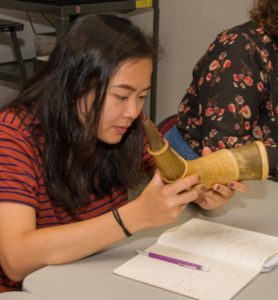

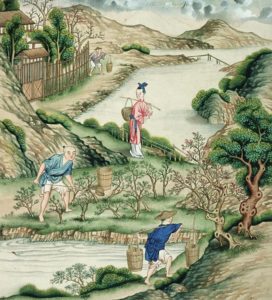
!["Women chusing [sic] the tea leaves" (7). Titles and the number in parentheses indicate inscriptions and sequence of image in the album. All images are courtesy of Historic Deerfield.](https://decorativeartstrust.org/wp-content/uploads/2019/01/1956-428_P7_PP-272x300.jpg)
